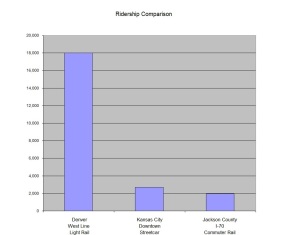
The new commuter rail “Canopy” at Denver’s historic Union Station. The old station building is at the top of the photograph connected to the rail terminal by the portico shown; and to buses and light rail by facilities below the rail level.
The Regional Transit Alliance series on Transit and Economic Development recently had a luncheon talk by Phillip A. Washington, General Manager of Denver’s Regional Transit District (RTD). Mr. Washington testified to the ability of transit to concentrate development around transit stations. The RTD is an active partner in development, with a Manager of Development and a staff of five people.

Rendering of Denver Union Station showing new streets, pedestrian mall and underground bus-way. Note development on either side of street/pedestrian mall. Subterranean walkway, surface streets and pedestrian mall connect to light rail stop.
As readers of this blog are probably aware, Denver already had a large transit network, both rail and bus, and is now in the midst of a $4.7 billion transit improvement project called “Fastracks“. The program includes light rail, commuter rail, BRT, and a radical re-purposing of the old Denver Union Station as a multimodal hub.
The Union Station part of the project alone will cost about $500 million and utilizes some nine different funding sources including six different Federal sources. The light rail facility is located a few blocks from the commuter rail and bus facility. The distance between the two is spanned by a wide pedestrian mall which was part of approximately 50 acres of vacant land (former rail yards) surrounding the station. See an artist’s rendering of the completed mall.
Land not used for transit facilities is being developed by a partnership of Union Station Neighborhood Corporation, two private development companies in the Denver area, the RTD, and the City of Denver. The next photograph shows the new Union Station Light Rail facility and some recent development around Union Station.
With 50 acres of downtown real estate, two of the most experienced developers in Denver as partners, and RTD’s own staff focused on development, one is not surprised that Mr. Washington is bullish on development around transit stations. One might add, “And how!”.

New Union Station light rail facility on first day of operations of the “West Line” light rail. Note new mixed use development in background.
The photograph also shows the opening day of the West Line or “W Line”, light rail line. Opened in April, 2013, it was the first part of the FasTracks project completed. Running 12.1 miles between Denver Union Station and Golden, Colorado, at a cost of $709 million; the line is estimated to carry 18,000 riders per day. In fact, ridership was about 14,000 in the initial months, without the benefit of college students commuting to colleges along the route.
Eighteen thousand riders per day sounds staggering to anyone familiar with ridership estimates for Kansas City area transit projects over the years. For example, the Ridership Comparison chart shows Denver’s West Line compared with two current Kansas City area projects. (Ridership for the I-70 commuter rail is the average ridership projected from the two models used for the 3rd and Grand terminus in the Jackson County Commuter Corridors Alternatives Analysis (JCCC AA))

Click To Enlarge
These projects are not strictly comparable as they include different modes, serve different sorts of neighborhoods, and Denver’s ‘W Line’ is integrated into an existing rail transit network. Be that as it may, Kansas City projects generally continue to show low estimated ridership numbers compared with projects elsewhere – a consequence of our history of well designed boulevards and extensive interstate system.
Low estimated ridership for rail proposals also causes cost-per-rider to be high. This measure of cost effectiveness, used by the Federal Transit Administration, often inhibits the Kansas City area’s ability to attract Federal Funds.
Note however, as the Annual Capital Cost per Rider chart indicates, that the downtown streetcar, which recently received a Federal TIGER grant, has a lower cost per rider than Denver’s West Line. This is due to both lower construction cost per mile and relatively strong ridership for the short 2 mile distance.
By contrast, the proposed Jackson County commuter rail project has a very high cost per rider due to very low estimated ridership, even though the capital cost, at $385 million (average of estimated range from the JCCC AA), is much lower than Denver’s West Line.

Click to Enlarge
While it is a good measure of system efficiency, ridership is not the only factor relevant to evaluating a transit project’s success. Commercial development and indirect job creation are other important parameters, as Mr. Washington pointed out.
One of the lessons to be drawn from his talk, albeit indirectly, is that development around transit stations doesn’t just happen, It requires the transit agency and units of local government to be proactive, and partner with experienced developers from the private sector to make projects happen. Surely it also helps if you have fifty acres of undeveloped property adjacent to the city center that happens to also be next to one of your stations.
![]() KCATA, City of Kansas City, MO, and Mid-America Regional Council are having a public meeting to discuss the possibility of a MAX line on Prospect from Downtown to South Kansas City.
KCATA, City of Kansas City, MO, and Mid-America Regional Council are having a public meeting to discuss the possibility of a MAX line on Prospect from Downtown to South Kansas City.




